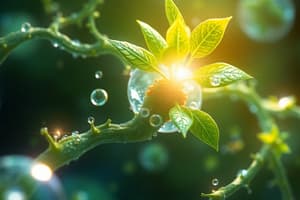Podcast
Questions and Answers
What type of membrane surrounds cells?
What type of membrane surrounds cells?
- Channel
- Bipedal
- Bilipid (correct)
- Trilipid
Which part of a cell is known as the 'power house'?
Which part of a cell is known as the 'power house'?
- Trilipid
- Channel
- Mitochondria (correct)
- Nucleus
In which part of the cell does photosynthesis take place?
In which part of the cell does photosynthesis take place?
- Mitochondria
- Nucleus
- Chloroplasts (correct)
- Channel
Which element is most commonly found in the human body?
Which element is most commonly found in the human body?
What term describes a community of animals and plants living in one place?
What term describes a community of animals and plants living in one place?
Which of the following is another name for Earth?
Which of the following is another name for Earth?
What medical condition occurs when cells begin to divide uncontrollably?
What medical condition occurs when cells begin to divide uncontrollably?
Which molecule carries the information or blueprint of a cell?
Which molecule carries the information or blueprint of a cell?
What is the process that results in the creation of new cells?
What is the process that results in the creation of new cells?
Which process involves the cellular conversion of the sun's energy?
Which process involves the cellular conversion of the sun's energy?
What is the term for communities of living things interacting with non-living things?
What is the term for communities of living things interacting with non-living things?
What are the building blocks that are smaller than atoms?
What are the building blocks that are smaller than atoms?
Which structure is considered the control center of a cell?
Which structure is considered the control center of a cell?
What is the smallest unit of life?
What is the smallest unit of life?
Which organism served as a carrier of Bubonic Plague in Europe in the 17th century?
Which organism served as a carrier of Bubonic Plague in Europe in the 17th century?
Which part of a cell allows water and food to pass in and out?
Which part of a cell allows water and food to pass in and out?
Which of the following is an example of a carbohydrate?
Which of the following is an example of a carbohydrate?
Which of the following are the parts of cells?
Which of the following are the parts of cells?
What instrument was used to see the first cell?
What instrument was used to see the first cell?
Approximately how many cells are in an adult human body?
Approximately how many cells are in an adult human body?
A trilipid membrane is the most common type of membrane surrounding cells.
A trilipid membrane is the most common type of membrane surrounding cells.
The nucleus is the powerhouse of the cell.
The nucleus is the powerhouse of the cell.
Mitosis is responsible for cellular conversion of the sun's energy.
Mitosis is responsible for cellular conversion of the sun's energy.
The genetic information of a cell is stored in the ______.
The genetic information of a cell is stored in the ______.
An ______ is a community of living organisms interacting with their non-living environment.
An ______ is a community of living organisms interacting with their non-living environment.
______ are building blocks that are smaller than atoms.
______ are building blocks that are smaller than atoms.
Match the following cell parts with their functions:
Match the following cell parts with their functions:
Match the following terms with their descriptions:
Match the following terms with their descriptions:
Why is oxygen the most common element found in the human body?
Why is oxygen the most common element found in the human body?
Explain the role of the cell membrane in the cell.
Explain the role of the cell membrane in the cell.
Flashcards
Cell Membrane
Cell Membrane
A double layer of lipids that surrounds a cell, providing a barrier and containing various proteins for transport and signaling.
Mitochondria
Mitochondria
Known as the "powerhouse" of the cell, this organelle generates most of the cell's supply of adenosine triphosphate (ATP), used as a source of chemical energy.
Chloroplast
Chloroplast
The organelle in plant cells where photosynthesis occurs, converting light energy into chemical energy in the form of glucose.
Oxygen
Oxygen
Signup and view all the flashcards
Ecosystem
Ecosystem
Signup and view all the flashcards
Earth
Earth
Signup and view all the flashcards
Cancer
Cancer
Signup and view all the flashcards
DNA
DNA
Signup and view all the flashcards
Mitosis
Mitosis
Signup and view all the flashcards
Photosynthesis
Photosynthesis
Signup and view all the flashcards
Ecosystem
Ecosystem
Signup and view all the flashcards
Quarks
Quarks
Signup and view all the flashcards
Nucleus
Nucleus
Signup and view all the flashcards
Cell
Cell
Signup and view all the flashcards
Flea
Flea
Signup and view all the flashcards
Channel
Channel
Signup and view all the flashcards
Glucose
Glucose
Signup and view all the flashcards
Organelle
Organelle
Signup and view all the flashcards
Microscope
Microscope
Signup and view all the flashcards
Trillion
Trillion
Signup and view all the flashcards
Study Notes
- The type of membrane surrounding cells is bilipid.
- The "power house" of the cell is called mitochondria.
- Photosynthesis takes place in the chloroplasts.
- The most common element found in the body is oxygen.
- Animals and plants that live in one place are called an ecosystem.
- Earth is also known as the biosphere.
- When cells begin to divide uncontrollably, the illness is called cancer.
- DNA can be know as the information or blueprint of a cell.
- Mitosis is the process of creating/making new cells.
- Photosynthesis is the cellular conversion of the sun's energy.
- An ecosystem is a community of living things interacting with non-living things.
- Quarks are the building blocks that are smaller than atoms.
- The cell control center is the nucleus
- The cell is the smallest unit of life.
- Fleas carried the Bubonic Plague in Europe in the 17th century.
- The cell allows water and food to pass in and out.
- Glucose is a type of carbohydrate.
- Cells are parts of a cell, known as organelles.
- The microscope was the instrument used to see the first cell.
- The number of cells in an adult human body is 60-90 trillion.
Studying That Suits You
Use AI to generate personalized quizzes and flashcards to suit your learning preferences.




